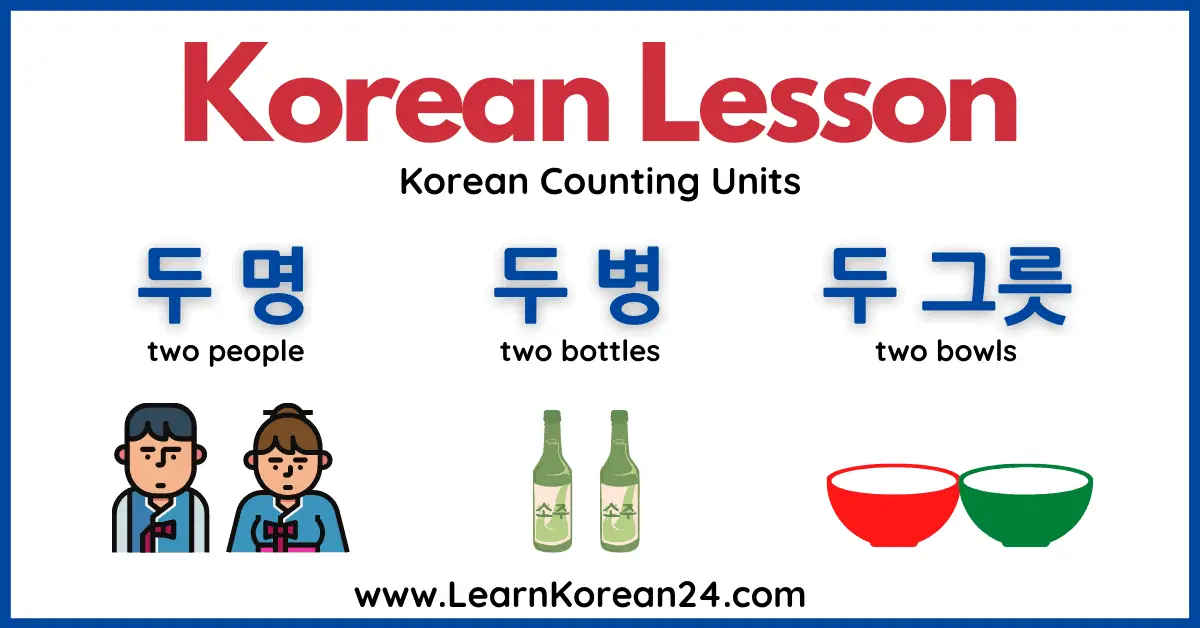Korean Counting Units
In this lesson, you will learn about Korean counting units, and how to ask and answer ‘How many?‘ in Korean. In order to ask and answer ‘How many?’ in Korean, you need to know Korean numbers and Korean counting units. In the previous lesson, you learned Sino Korean numbers and native Korean numbers.
In this lesson, we will teach you how to ask ‘How many?’ in Korean and how to use Korean counting units together with Korean numbers to answer this question. First, let’s look at the basic way to say ‘How many?’ in Korean.
‘How Many?’ In Korean
Before we learn about Korean counting units, let’s first look at how to say ‘How many?’ in Korean. In English, the word ‘how’ has different functions. For example, when asking ‘How many?’ , ‘How much?’, ‘How did you do that?’, etc, in English, the word ‘how’ is the same In Korean, however, there are 6 different ways to say ‘How’ in Korean.
In a previous lesson, you learned that ‘How much is it?‘ in Korean is ‘얼마예요?‘. In this sentence, ‘how’ is 얼마 and 예요 is an ending which means ‘is equals to’. When asking ‘How many?’ in Korean, a different word for ‘how’ is used. So, how do you say ‘how many’ in Korean?
The most basic way to ask how many in Korean is 몇 개예요? [myeot gae-ye-yo]. This is made up of 몇 (how many) + 개 (a Korean counting unit meaning ‘thing’) + 예요 (ending which means ‘is equals to’).
As this way of saying ‘How many?’ in Korean includes the Korean counting unit 개, meaning ‘thing’, this literally means ‘How many things?’ or ‘How many are there?’. This can be used in many situations to ask about how many objects there are. Here are some other example sentences using the Korean counting unit 개:
| English | Korean | Listen |
|---|---|---|
| How many did you buy? | 몇 개 샀어요? | |
| I bought one. | 한 개 샀어요. | |
| How many did you eat? | 몇 개 먹었어요? | |
| I ate two. | 두 개 먹었어요. | |
| How many do you have? / How many are there? | 몇 개 있어요? | |
| I have five./There are five. | 다섯 개 있어요. |
Korean Counting Units
The Korean counting unit 개 cannot be used in all situations. There are many different counting units in Korean and if you don’t know a particular counting unit you can usually just use 개 instead. However, you cannot use 개 when referring to people, animals, or actions. Instead, you should use the correct counting unit.
| English | Korean | Listen |
|---|---|---|
| counting unit for people | 명 | |
| How many people? | 몇 명이에요? | |
| counting unit for animals | 마리 | |
| How many animals? | 몇 마리예요? | |
| counting unit for actions | 번 | |
| How many times did you see that movie? | 그 영화 몇 번 봤어요? |
Common Korean Counting Units
Here are some of the most common Korean counting units:
| Counting Unit | Korean | Listen |
|---|---|---|
| bottles | 병 | |
| glasses/cups | 잔 | |
| bowls | 그릇 | |
| plates | 접시 | |
| ‘pieces’ or ‘slices’ | 조각 | |
| books | 권 | |
| cars | 대 | |
| tickets | 장 |
Counting In Korean
When counting things in Korean and answering the question ‘How many?’, native Korean numbers are used. However, native Korean numbers only go up to 99. If you are counting anything that is more than 99 things, then sino-Korean numbers are used. To review native and sino-Korean numbers, check out our complete guide to numbers in Korean.
Another important thing to remember is that when adding a counting unit to numbers 1,2,3, 4, and 20 the words for these numbers change slightly. Let’s look at some examples:
- ‘One Thing’ in Korean is 하나 (one) + 개 (counting unit meaning ‘thing’) = 한 개 (not 하나 개)
- ‘Two People’ in Korean is 둘 (two) + 명 (counting unit for people) = 두 명 (not 둘 명)
- ‘Three Bottles’ in Korean is 셋 (three) + 병 (counting unit for bottles) = 세 병 (not 셋 병)
- ‘Four Glasses’ in Korean is 넷 (four) + 잔 (counting unit for glasses) = 네 잔 (not 넷 잔)
- ‘Twenty Birds’ in Korean is 스물 (twenty) + 마리 (counting unit for birds) = 스무 마리 (not 스물 마리)
For all other native Korean numbers and Sino-Korean numbers for things more than 99, the word doesn’t change. Simply add the counting unit after the number to say how many of that thing there are. Here are some useful example sentences using counting units in Korean. The counting units are in bold.
| English | Korean | Listen |
|---|---|---|
| Give me one bottle of cola, please. | 콜라 한 병 주세요. | |
| How many people? | 몇 명이에요? | |
| Four people. | 네 명이에요. | |
| Give me two glasses, please. | 두 잔 주세요. | |
| Give me one bowl of rice, please. | 밥 한 그릇 주세요. |
Are you ready to get serious about learning Korean? Start our 100% FREE online Korean language course today!

